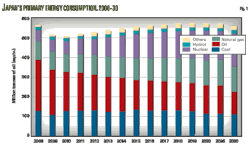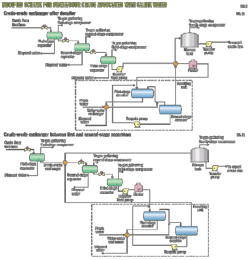An oil play is under way on the eastern Chaco slope of the San Juan basin in northwestern New Mexico, where 17 zones from 400 ft to 4,000 ft have oil potential, including unconventional oil from the Cretaceous Mancos shale.
Mancos is the stratigraphic equivalent of the Cretaceous Niobrara formation in the northern Denver-Julesburg basin, where a horizontal Niobrara oil play began last year (OGJ Online, Apr. 7, 2010).
In New Mexico's Rio Puerco Mancos field, unstimulated flow rates have been comparable to those EOG Resources Inc. has experienced from stimulated horizontal wells in the DJ basin. One well drilled in Rio Puerco Mancos field of Sandoval County, NM, had an initial potential of 1,122 b/d of oil from Mancos in 1984. And a horizontal lateral drilled in 1991 from an offset to that well has produced more than 104,000 bbl of oil without stimulation and is still making 10-15 b/d.
Chaco slope oil
Some see potential for fractured Mancos shale to produce oil all around the rim of the San Juan basin.
Oil in the San Juan basin dates to Seven Lakes field, a 1911 discovery on the south-central Chaco slope in McKinley County.
That intended water well initially made 12 b/d of oil from the Menefee member of Mesaverde at 330 ft, and wells in Seven Lakes field produced for over 90 years before being plugged.
The Chaco slope covers roughly 6,800 sq miles between Gallup and Cuba, NM. Brock and Gray, writing in the AAPG Bulletin in 1973, described the Chaco Slope as the "gently dipping, southern margin of the San Juan basin, bounded by the Zuni Mountains on the south, the Nacimiento Mountains on the east, the Defiance uplift on the west, and the 'main gas producing trend' of the San Juan basin on the north."
Hospah field, with cumulative production topping 23 million bbl, is the largest oil field on the Chaco slope. It is in northeastern McKinley County 60 miles southwest of Rio Puerco Mancos field. After the field's main Hospah sands at 1,500 ft are depleted, an additional 3.5 million bbl of oil is estimated to be recoverable from Mesaverde at 300 ft.
Rio Puerco field
Rio Puerco field was discovered in 1982, and the field has good and poor vertical wells that were drilled in attempts to intersect fractures. The Rio Puerco Mancos well with the largest cumulative production, 146,000 bbl, had one of the largest frac jobs. The highest cumulative recovery from an unstimulated well has been 134,000 bbl of oil.
In 1991, Veteran Exploration drilled several horizontal wells and a horizontal lateral from the San Isidro 15-7 well. That 2,750-ft lateral has produced more than 66,000 bbl of oil and still makes 10-15 b/d.
In the north half of 12-20n-3w in the field, two vertical wells were drilled, and then a horizontal well was drilled after the vertical wells were depleted. Those three wells recovered a combined 186,000 bbl of oil, one third of which came from the horizontal well which was unstimulated.
Horizontal wells are expected to cost around $1.1 million because the Mancos is relatively shallow and spacing is 320 acres, limiting the length of the horizontal laterals.
In February 2010, CBM Partners Inc., a Russian company, staked the Smylov H-2 well in 21-20n-3w as a horizontal Mancos well in Rio Puerco field.
When Gary Williams spaced Rio Puerco Mancos field, the company compared attributes of the Mancos in Rio Puerco and West Puerto Chiquito fields (Table 1).
Most of the basin's Mancos oil has come from four fields in Rio Arriba County, which are about 60 miles north of Rio Puerco Mancos field. Those fields are East and West Puerto Chiquito, Gavilan, and Boulder fields, and they account for roughly three quarters of all production from the Mancos shale formation in the San Juan basin.
The US Geological Survey estimated that 189 million bbl of technically recoverable resources remain to be discovered and produced from the Mancos shale on the Jicarilla Apache Indian Reservation in the eastern San Juan basin (OGJ, Dec. 2, 2002, p. 42).
Federal land sales
At the US Bureau of Land Management's competitive lease sales in the first half of 2010, the high bids for parcels in and around Rio Puerco Mancos field jumped from $360/acre to $520/acre in January and to $570-625/acre in April.
Some 77,832 acres of land in the San Juan basin were nominated initially for the BLM's competitive lease sale held July 21. That nominated acreage included 15,655 acres in Rio Puerco Mancos field and 11,752 acres in the 1-mile buffer zone around the field.
However, only 9,262 acres were offered, none of it in or around the field. The reason for that reduction is a resource management plan that is expected to take 2 years to prepare. As a result, drilling and development can take place only on existing leases, until the plan is completed.
Mancos oil used to be trucked to the Bloomfield, NM, refinery, but since that was mothballed it moves via pipeline to Western Refining's 23,000 b/d Ciniza refinery just east of Gallup (OGJ Online, Nov. 10, 2009). The Mancos crude is as much as 11% paraffin for high yields of gasoline and jet fuel.
Producing zone added
The Chaco slope's 17 producing zones may have had an addition earlier this year.
Finley Resources, a private Fort Worth operator, in early 2010 appears to have opened oil production from a new zone for the basin. The well's producing capability isn't known, but it is perforated in the Lower Point Lookout formation, also called Tres Hermanos, of Mesaverde. Casing pressure is 980 psi.
Finley Resources in March 2010 plugged back the San Isidro 16-10 well from the Mancos and recompleted it in Mesaverde, which the company referred to as Lower Point Lookout. A test on Mar. 16 yielded 22 bbl of oil with no gas or water, and oil was sold from the well in April.
More Oil & Gas Journal Current Issue Articles
More Oil & Gas Journal Archives Issue Articles
View Oil and Gas Articles on PennEnergy.com




